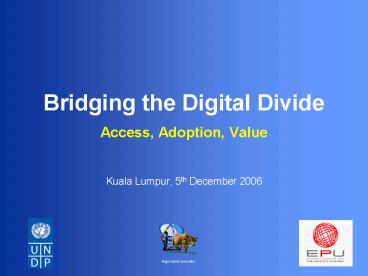Bridging the Digital Divide Access, Adoption, Value - PowerPoint PPT Presentation
1 / 19
Title:
Bridging the Digital Divide Access, Adoption, Value
Description:
Bridging the Digital Divide Access, Adoption, Value Kuala Lumpur, 5th December 2006 Roger Harris Associates Agenda Understanding the digital divide Malaysia s ... – PowerPoint PPT presentation
Number of Views:119
Avg rating:3.0/5.0
Title: Bridging the Digital Divide Access, Adoption, Value
1
Bridging the Digital DivideAccess, Adoption,
Value
- Kuala Lumpur, 5th December 2006
2
Agenda
- Understanding the digital divide
- Malaysias digital divide
- Malaysias socio-economic divide
- Experiences, lessons and findings
- Policies for closing the digital divide
- Framework for bridging the digital divide
3
Understanding the Digital Divide
- The Digital Divide is a socio-economic situation
that arises when a segment or segments of society
have unequal access to contemporary Information
and Communication Technologies (ICTs) for gaining
and contribution information/knowledge and to
derive benefits there from. - The Digital Value Divide is seen as that which
prevents certain sections of Malaysian Society
from being able to benefit from a more equitable
share in the socio-economic value that ICTs are
capable of generating towards the fully developed
status of the Nation. - The Digital Divide is concerned with access to
ICTs. - The Digital Value Divide is concerned with
enjoyment of the benefits that ICTs bring. - The term e-inclusion is used for the goal of
narrowing the digital divide for the benefit of
underserved sections of society. - As ICTs by default benefit the already
advantaged, it is possible to narrow the digital
divide without having an appreciable impact on
e-inclusion.
4
Understanding the Digital Divide
Socio-economic value of ICTs
Time
5
Malaysias Digital Divide
- 8-S categorisation of mukims
- Skaters best performers
- Striders
- Sprinters
- Sliders
- Strollers
- Shufflers
- Starters
- Sleepers worst performers
6
Malaysias Digital Divide
7
Malaysias Digital Divide
8
Malaysias Socio-economic Divide
9
Malaysias Socio-economic Divide
10
Experiences and Lessons Pusat Internet Desa
11
Findings Access and Adoption
- Malaysias digital divide remains highly
pronounced - Mobile phones have overtaken fixed lines
- Radio and TV are at saturation
- Internet has hardly begun
- Computers are off the bottom rung
- There is a relationship between the spatial
digital divide and the social divide - Infrastructure programmes are effectively
acculturating Malaysians to ICTs. - But they are not being utilised as much as they
could be to deliver socio-economic value.
12
Findings Programmes
- Current development programmes are largely
uncoordinated - Earlier lessons are not being adequately applied
to current initiatives - The reach of programmes to underserved sections
of society is uneven - Many development programmes are not making use of
the most ubiquitous ICTs (Handphones, TV Radio) - Some programmes with ICTs are not making use of
the existing ICT infrastructure - Some programmes within the same Ministry are
proceeding with their own infrastructures - Some programmes are not taking the opportunity to
use ICTs where they could
13
Findings Policies
- Policies for ICTs have not been blended into
policies for socio-economic development for
underserved groups. - But Malaysia has a history of effective policy
making for ICTs for social inclusion. - Current policy mechanisms are not specific about
the value aspect of ICTs for achieving
e-Inclusion.
14
Five Thrusts of e-Inclusion
Thrust 1 Increase access and adoption of ICTs by
underserved groups
Thrust 5 Institutionalise evidence-informed
policy and practice.
Thrust 2 Create value in e-inclusion programmes
Thrust 3 Develop local content through
participatory approaches.
Thrust 4 Cultivate multi-stakeholder
collaboration and coordination.
15
Policies for Closing the Digital Divide
Thrust 1. Increase access and adoption of ICTs
by underserved groups
- Ensure equitable access to affordable PCs and
online services. - Increase adoption and usage of networked
applications.
Thrust 2. Create value in e-inclusion programmes
- Target e-inclusion rather than closing the
digital divide. - Infuse ICTs further within existing development
programmes for underserved groups. - Improve the performance of telecentres to achieve
and increase their socio-economic value.
16
Policies for Closing the Digital Divide
Thrust 3. Develop local content through
participatory approaches.
- Adopt improved methodologies for e-inclusion
programme design and implementation. - Provide financial support for community-based
local content development. - Promote generic local content for customisation,
interactivity and localisation.
Thrust 4. Cultivate multi-stakeholder
collaboration and coordination.
- Integrate and co-ordinate policy-making and
programme design for e-inclusion. - Incorporate civil society voices within the
policy advisory process. - Increase capacity at all levels for creating
e-inclusion.
17
Policies for Closing the Digital Divide
Thrust 5. Institutionalise evidence-informed
policy and practice.
- Adopt improved methodologies for evaluating
e-inclusion programmes. - Target e-inclusion indicators that measure the
socio-economic benefits of technology. - Collect data for monitoring progress towards
e-inclusion
18
The National Strategic Framework for Bridging the
Digital Divide
19
Thank you
- QA.































